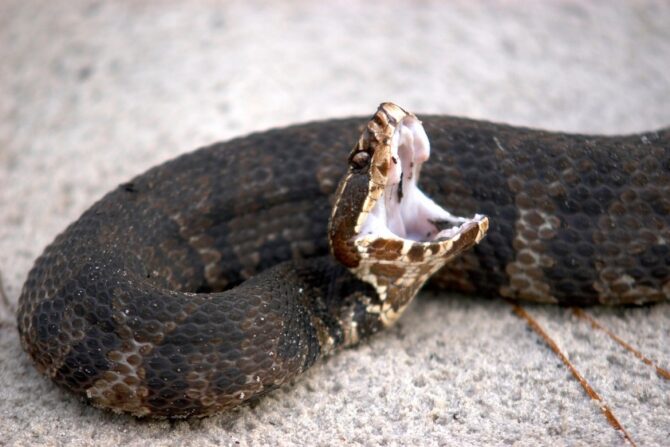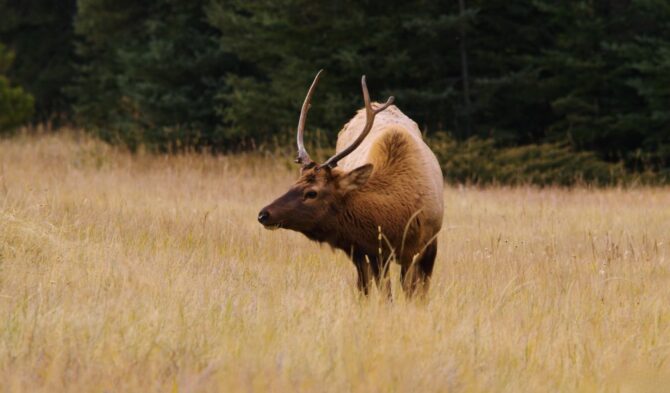Located in the southeastern part of the United States, Virginia is one of the 13 original colonies in America with historic landmarks.
It is also home to many snakes, most of which are harmless. However, the exception is three venomous snakes that are all categorized as pit vipers.
The venomous snakes in Virginia are the eastern copperhead, the cottonmouth (or water moccasin), and the timber rattlesnake.
Continue reading to learn more about these venomous snake species and how to recognize them based on their distinguishing features.
3 Venomous Snakes in Virginia
1. Eastern Copperhead

- Scientific Name: Agkistrodon contortrix
- Size: 24 to 36 inches
- Habitat: Forest, marshes, Brock outcrops, and old fields
- Identifying Features: Vertical pupils, cat-like eyes, triangular head that’s wider than the neck, a pit between the eyes and nostril, dark brown hourglass-shaped marking with light reddish brown color
- Behavior: Secretive, shy, loud hissing, flattens its body, violent movement, sweeps about when disturbed
- Threats: Rarely lethal venom, warning or dry bite, severe pain and nausea, tingling sensation, throbbing, and swelling
Copperheads can be found all over Virginia.
They have angular heads, pits on both sides of their snots, a heavy body, and markings shaped like an hourglass.
These snakes are found mostly in forests, marshes, rock outcrops, old fields, and swamps.
During the hot summer months (usually from June to August), copperheads become nocturnal. However, in much colder seasons, they are mostly diurnal.1
Unlike most venomous snakes, copperheads are not aggressive and rarely bite humans.
However, their bite is venomous and usually results in the following symptoms: severe pain and nausea, vomiting, throbbing, swelling, and a tingling sensation.
Because of their excellent camouflage, it’s usually hard to spot copperheads.
Usually, they don’t bite humans unless they are stepped on by mistake.
When threatened, copperheads exhibit several self-defense mechanisms, including vibrating their tail more than 40 times per second when approached—faster than any other non-rattlesnake species.2
They also bite predators without injecting venom to scare them away. This is called a dry or warning bite.
2. Cottonmouth

- Scientific Name: Agkistrodon piscivorus
- Size: 30 to 42 inches
- Habitat: Damp areas like streams, lakes, swamps, ponds, and roadside drainage.
- Identifying Features: Dark olive-brown color, thickset, fat, bright white mouth like cotton, mostly plain or patterned skin
- Behavior: Violent flight, rapid crawling, raising head and neck, expanding jaw, vibrating tail, flickering of the tongue, striking forward and crouching
- Threats: Lethal bite, huge swelling, severe pain, tissue damage, and loss of arms
Cottonmouths, also called water moccasins, are dangerous semi-aquatic snakes found mostly in southeastern Virginia.
They are classified as semi-aquatic because they can live both on land and in water.
Cottonmouths derive their name from their mouth, which is as white as cotton when wide open.
They are mostly found near slow-moving water bodies like streams, marshes, and shallow lakes.
The color pattern of their skin consists of brown, gray, tan (yellowish-brown), yellowish-olive, or blackish-brown.
Cottonmouths feed on vertebrates and invertebrates animals like mammals, birds, lizards, frogs, fish, eggs, and insects.
When threatened, they display several aggressive traits, like hissing, vibrating their tails, or throwing their heads backward with their mouth wide open.
In extreme cases, cottonmouths flatten their bodies and emit strong, pungent secretions from the anal glands at the end of their tails.
Symptoms of their bite include severe pain, bruise, swelling, destruction of tissues, and death.
3. Timber Rattlesnake

- Scientific Name: Crotalus horridus
- Size: 36 to 60 inches
- Habitat: Deciduous hardwood forests, rugged terrain, lowlands, wetlands, and dens near residential areas
- Identifying Features: Large, heavy bodies, large dark brown or black crossbands, reddish-brown stripes, pinkish gray body, and black tails
- Behavior: Solitary, rarely aggressive toward people, uses camouflage, hibernates in dens during winter, relates with copperheads and black rat snakes, roam at night (especially during summer)
- Threats: Dangerous bites, severe pain, bleeding, redness, numbness, and death
Timber rattlesnakes, also called canebrakes, are among the venomous rattlesnake species found in the mountainous region on the western side of Virginia.
They are a highly venomous endangered snake species.
Timber rattlesnakes are characterized by a round head and a prominent rattle at their V-shaped tail end, which they use to warn off potential predators.
Their color may be yellow, tan (yellowish-brown), or gray.
They have triangular-shaped heads and a pattern of large black crossbands all over their body.
They can be found in high areas around rivers, flood plains, lowlands, thick bushes, farms, and deciduous forests.
When hunting their prey, timber rattlesnakes use two methods: stalking and ambush.
They feed on terrestrial vertebrates and invertebrates, like mice, chipmunks, rabbits, squirrels, birds, frogs, and other snakes.
Their venom contains hemotoxin, which causes the following deadly symptoms: tissue damage, bleeding, skin discoloration, and death.
Final Thoughts
Virginia is truly a lovely place to visit.
However, if you’re worried about getting bitten by a snake, you can take necessary precautions with the information in our list of venomous snakes in Virginia.
Even though most of the snakes in Virginia are non-venomous, it’s always safer to avoid touching any animal you encounter.
Finally, be cautious when exploring areas in Virginia known to be that snake habitat, and you’ll stay safe from venomous snakes.
References & Notes
- Eastern Copperhead. Missouri Department of Conservation
- Eastern Copperhead (Fort Worth Area Snakes). iNaturalist






